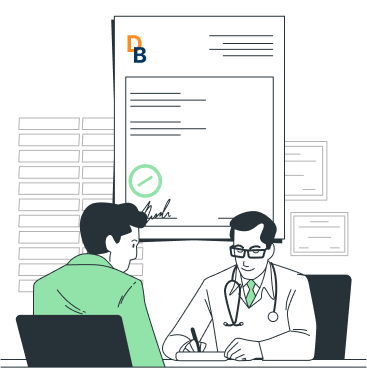Expert Doctor
What are Piles?
Haemorrhoids or Piles are known to be swollen veins in the lower rectum and anus. They can occur in the external region around the anal opening or in the internal region within the rectum. It is a common condition among people of different genders and ages. But, it is often seen among those who are around 50 to 60 years old. Piles treatment usually involves some lifestyle changes like maintaining good hygiene, increasing the intake of fiber, drinking plenty of water, using over-the-counter ointments and creams and avoiding straining at the time of bowel movements. However, in more severe cases, surgery is recommended.
Frequently Asked Questions
To help prevent piles during pregnancy, you must stay hydrated by drinking plenty of water, eat a high-fibre diet rich in fruits, vegetables, and whole grains, exercise regularly, as permitted by the doctor and avoid prolonged sitting or standing.
Bleeding that soaks through undergarments in a short period or bleeding that is accompanied by severe pain or other concerning symptoms should be evaluated by a doctor. If in doubt, it’s always best to consult a doctor.
The cost of piles surgery can vary widely based on factors like the type of surgery, experience and reputation of the doctor, and the healthcare facility.
Common symptoms of piles include bleeding during bowel movements, pain or discomfort in the anal area, itching or irritation around the anus, swelling or a lump near the anus or mucus discharge after bowel movements
While stress itself may not directly cause piles, it can contribute to behaviours like poor diet and decreased physical activity, which can increase the risk of developing piles. Managing stress through relaxation techniques can help improve overall health.
Most people are advised to take about 3 to 7 days off from work, depending on individual recovery and the type of surgery performed. It’s important to follow the doctor’s specific recommendations.
Yes, piles surgery is generally considered a safe option and is commonly performed. However, like any surgery, it carries some risks. It's important to discuss potential risks and benefits with our doctor.
Some bleeding can be expected after piles surgery, especially within the first few days. However, if you experience significant or persistent bleeding, it’s essential to contact our doctor.
Advantages of Piles Laser Surgery
1. Minimal cuts
The cuts made during laser surgery are usually minimal in comparison to the cuts made during open surgery.
2. Less pain:
Patients usually report less pain during piles laser surgery, while patients who undergo piles open surgery tend to experience more pain.
3. Less scarring and stitches:
Scars and stitches are minimal in laser surgery for piles in contrast to those of open surgery.
4. Minimal loss of blood:
Blood loss during laser treatment of piles is minimal compared to open surgery.
5. Low risk of infections:
The risk of infections are lower in case of laser piles treatment.
6. Short hospital stay:
As per a piles surgeon in Kolkata, the hospital stay for laser piles surgery is shorter than the hospital stay after open surgery.
7. Quicker recovery:
The recovery period after surgical piles treatment with laser is quicker than the recovery period after open piles surgery.
8. Advanced technology:
Piles treatment utilises advanced technology while open surgery as a traditional method uses outdated technology.
Kinds and Grades of Piles
Piles, or haemorrhoids, can be classified based on their location and severity as follows:
Internal Piles
Internal piles develop inside the rectum, above the dentate line, making them invisible from the outside. They are categorised into four grades based on their severity and prolapse:
These are the mildest forms of internal piles. They are small in size and remain inside the rectum. Moreover, they do not protrude through the anus. Grade 1 piles usually cause no symptoms and are often treated with conservative methods like lifestyle changes and topical creams or ointments.
-
Grade 1:
These are the mildest forms of internal piles. They are small in size and remain inside the rectum. Moreover, they do not protrude through the anus. Grade 1 piles usually cause no symptoms and are often treated with conservative methods like lifestyle changes and topical creams or ointments.
-
Grade 2:
Grade 2 piles are larger and may protrude from the anus during bowel movements but retract spontaneously afterwards. Non-surgical treatments such as rubber band ligation, infrared coagulation, or sclerotherapy may be effective.
-
Grade 3:
These piles protrude during bowel movements and do not retract on their own, requiring manual repositioning. They can cause pain, itching, bleeding, and hygiene difficulties. Treatment options include rubber band ligation, infrared coagulation, and sclerotherapy.
-
Grade 4:
Grade 4 piles remain prolapsed and cannot be manually repositioned. These are large, inflamed, and highly sensitive, often causing intense pain, bleeding, and hygiene issues. Complications like thrombosis or strangulation may occur, and surgical options such as laser surgery or stapled hemorrhoidectomy are usually required.
External Piles
External piles develop around the outer opening of the anus and appear as visible lumps. Located below the dentate line, they may cause symptoms like pain, itching, and discomfort.
Conservative treatment options include topical creams or ointments, and pain medications. However, if these treatments fail to provide relief or if the condition worsens, surgical options such as laser surgery or stapled hemorrhoidectomy may be recommended.
Surgical intervention is often necessary when external piles become severe, leading to intense pain and discomfort.
Diagnosis of Piles
A proctologist or anorectal surgeon can diagnose piles through a combination of medical history, physical examination, and diagnostic tests when necessary. Here's an overview of the diagnostic process:
1. Medical History:
The doctor will ask about your symptoms, such as pain, itching, bleeding, or changes in bowel movements, as well as your medical history, including any prior occurrences of piles.
2. Physical Examination:
A visual and physical examination of the anal area will be performed to assess both external and internal piles. The doctor may gently examine the anus and rectum with gloved fingers to check for swelling, lumps, or other abnormalities.
3. Digital Rectal Examination (DRE):
In some cases, a digital rectal examination may be conducted, where a lubricated, gloved finger is inserted into the rectum to assess internal piles and other rectal issues. This procedure is quick and generally causes minimal discomfort.
4. Anoscopy or Proctoscopy:
These diagnostic tools involve inserting a small, lighted tube (anoscope or proctoscope) into the anal canal and rectum for a detailed examination. This allows the doctor to directly visualise the location, size, and severity of the piles and other rectal conditions, helping in treatment planning.
5. Sigmoidoscopy:
This procedure uses a sigmoidoscope (a lighted tube with a camera) to view the lower part of the colon and rectum. Both flexible and rigid sigmoidoscopies allow for direct visualisation of the rectum and lower sigmoid colon to help identify piles and other conditions.
6. Colonoscopy:
A colonoscopy examines the entire colon (large intestine) to identify abnormalities and investigate rectal bleeding that may be caused by piles or other conditions. It helps rule out more serious issues and guide appropriate treatment options.
Treatments for Piles
Piles can be treated with both surgical and non-surgical methods. Below are some common treatment options:
Surgical Treatments
Laser surgery for piles is recommended for severe piles or when non-surgical methods fail.
1. Open Surgery (Hemorrhoidectomy:
In this traditional method, an incision is made around the anus or in the anal canal to remove the piles. The surgeon may excise the piles or tie them off with sutures to cut off blood supply. Recovery can take several weeks to a few months, depending on the extent of the surgery and post-operative care.
2. Stapler Surgery (Stapled Hemorrhoidectomy):
This procedure uses a stapling device to remove piles tissue and is often used for prolapsed or large piles. Stapler surgery is associated with less pain, bleeding, and swelling compared to traditional surgery. Recovery is quicker, with fewer complications.
3. Laser Surgery
Laser surgery is a minimally invasive option that uses laser energy to shrink the piles tissue while leaving surrounding healthy tissue unaffected. This outpatient procedure is associated with minimal pain and a shorter recovery time.
Non-surgical Treatments
1. Rubber Band Ligation:
This is a common procedure for internal piles. A doctor inserts an anoscope to view the area, then uses a ligator to place a rubber band at the base of the piles. The band cuts off blood supply, causing the piles to shrink and fall off within a few days. The procedure takes about 30 minutes, with a short recovery time. Most people resume normal activities within a few days.
2. Sclerotherapy
In this procedure, a solution is injected into the affected vein, causing it to shrink and disappear. This is often used for internal piles and generally offers a quicker recovery than surgical interventions.
3. Infrared Photocoagulation
Used for small and medium-sized internal piles, this procedure uses infrared light to treat internal haemorrhoids, cutting off the blood supply to the piles, which eventually shrinks and falls off. Recovery time is short, with most people resuming activities immediately after the procedure.
4. Electrocoagulation
An electric current is used to destroy the piles. A probe is applied to the base of the piles, delivering a current that causes the blood vessels to thicken and get destroyed. The piles then shrink. Recovery time varies depending on the size and severity of the piles.
Comparison between Open and Laser Piles Surgery
| Sl. No | Aspect | Open Surgery (Hemorrhoidectomy) | Laser Surgery |
|---|---|---|---|
| 1 | Procedure Type | Traditional surgical removal of piles | Minimally invasive use of a laser to shrink piles |
| 2 | Incision | Involves cutting and removal of piles tissue | No cutting, laser coagulates piles tissue |
| 3 | Anaesthesia | General or local anaesthesia | Local anaesthesia |
| 4 | Pain | Moderate to severe pain | Minimal pain during and after the procedure |
| 5 | Recovery time | 4-8 weeks | 1-2 weeks |
| 6 | Scarring | High chances of scarring | Low chances of scarring |
| 7 | Recurrence | Low recurrence rate | Very low recurrence rate |
Laser Piles Surgery as an Effective Treatment
Laser surgery is a safer, quicker, and more effective surgical option for treating piles compared to other methods. Also known as laser hemorrhoidectomy or laser hemorrhoidoplasty, it is a minimally invasive procedure with several key advantages:
1. Quick Procedure:
The surgery generally takes around 30 minutes, depending on the number and location of the piles, and patients can usually go home shortly after without requiring a hospital stay.
2. High Success Rates:
Laser surgery is highly effective in removing or shrinking piles, offering long-term relief from symptoms like pain, bleeding, itching, and discomfort.
3. Minimal Postoperative Discomfort:
Patients experience less pain and discomfort after laser surgery, resulting in a smoother and more comfortable recovery compared to open surgery.
4. Lower Risk of Incontinence:
The laser precisely targets the piles without harming the surrounding anal sphincter muscles, reducing the risk of postoperative incontinence, a potential complication in other surgical procedures.
5. Lower Recurrence Risk:
By treating the piles tissue at its source, laser surgery reduces the likelihood of recurrence, making it more effective than non-surgical or conservative treatments.
Preparation for Piles Surgery
Before undergoing piles treatment, our proctologist will likely provide specific instructions to follow to ensure the procedure goes smoothly. These may include:
1. Fasting
Avoid eating or drinking anything for at least 12 hours before your surgery. This helps keep the stomach clean and prevents complications related to anaesthesia.
2. Medications:
If you are taking blood-thinning medications, you will need to stop taking them before surgery to reduce the risk of excessive bleeding during the procedure.
3. Shaving:
Do not shave the surgical area yourself, as this can increase the risk of infection.
4. Bowel Preparation
You may be advised to have a laxative or enema at least 12 hours before surgery to ensure the colon is clear during surgery.
5. Avoid Smoking and Alcohol:
Refrain from smoking or drinking alcohol for 3–4 days prior to surgery, as these can interfere with the healing process and anaesthesia.
6. Comfortable Clothing:
Wear loose, comfortable clothes that are easy to remove and won’t irritate your skin.
7. Transportation:
Arrange for someone to drive you home after the completion of the procedure. Anaesthesia can cause nausea, dizziness, or blurred vision, making it unsafe to drive or travel alone.
Best Doctor for Piles Surgery
Dactarbabu has the most qualified doctor for piles surgery. These doctors specialise in diagnosing and treating diseases and conditions of the colorectal region, including issues affecting the colon, rectum, and anus.
Recovery after Piles Laser Surgery
You should also keep the following points in mind:
- Keep the surgery site clean to prevent infection.
- Avoid lifting heavy objects, as this can put extra strain on the surgical area.
- Eat a nutritious, high-fibre diet and avoid oily or spicy foods.
- Drink at least 8-10 glasses of water daily to stay hydrated
- Do not strain during bowel movements.
- If bowel movements are hard, consider using stool softeners, but only after consulting our doctor.
- Follow our doctor’s instructions carefully regarding medications and the application of ointments or creams.
Dietary Guidelines for Piles
Here are some recommended foods for managing piles:
Good Foods for Piles
1. Flavonoid-Rich Foods:
Incorporate foods high in flavonoids, such as citrus fruits (oranges, lemons). These may strengthen blood vessels and reduce inflammation, relieving piles symptoms.
2. Healthy Fats
Include sources of healthy fats like seeds and olive oil in your diet. These can help lubricate the stool and facilitate easier bowel movements.
3. Probiotic Foods:
Eating probiotic-rich foods such as yoghurt can promote a healthy gut microbiome and improve digestion.
4. Adequate Fluid Intake:
Stay hydrated by drinking enough water and other healthy fluids throughout the day to prevent constipation and make stools easier to pass.
5. Vegetables:
Consume a variety of vegetables, especially leafy greens like spinach as well as broccoli, Brussels sprouts, carrots, and cauliflower. These are high in fibre and support healthy digestion.
6. Whole Grains
Include whole grains like whole wheat, oats and brown rice. These are high in fibre, helping regular bowel movements.
7. Legumes:
Add legumes such as lentils, chickpeas, and kidney beans to your diet. Their high fibre content is essential for maintaining regular bowel movements and preventing constipation, which can relieve discomfort associated with piles.
8. Nuts and Seeds:
Incorporate nuts and seeds like almonds, walnuts, and chia seeds. These can aid in healthy bowel movements, with walnuts and almonds being particularly high in fibre and anti-inflammatory properties.
Foods to Avoid or Limit
1. Meat:
Red and processed meats are low in fibre and difficult to digest, which can increase the probability of constipation and worsen piles.
2. Spicy Foods:
Spicy dishes can irritate the digestive system, leading to symptoms like itching, burning, and inflammation. It's best to reduce the consumption of spicy foods and sauces.
3. Alcohol:
Alcohol can cause dehydration and contribute to constipation. It's advisable to limit or avoid it when managing piles.
4. Processed Foods:
Fast food, packaged snacks, and processed meats are often low in fibre and high in unhealthy fats. These should be limited in your diet as they can lead to constipation.
5. Low-Fiber Foods
Foods like white rice, white bread, and plain pasta can make stools smaller and harder, increasing straining during bowel movements. It's best to avoid these low-fibre options.
7. Sugary Foods:
Limit or avoid foods high in refined sugars, such as candies, cakes, pastries, and sugary drinks. Excess sugar can disrupt gut bacteria balance and negatively impact digestion.
Dos after Piles Surgery
After surgery, the anal region will be quite sensitive, and it’s important to relax as much as possible during the initial weeks of recovery. Be sure to follow the post-operative care instructions provided by the doctor. Here are some general tips to aid in your recovery:
1. Maintain Cleanliness
Keep the anal area dry and clean. After each bowel movement, take a warm water bath that helps reduce discomfort. Soaking the area in warm water can soothe the anal sphincter, promote blood flow to the tissues, and aid in healing while reducing pain, itching, and irritation. You may also use wet tissues for cleaning, but avoid excessive wiping.
2. Limit Physical Activities
Gradually ease back into physical activities over the first few days. Avoid lifting heavy weights or engaging in strenuous exercises for at least two to three weeks. However, keep moving and walking lightly to promote circulation without putting too much strain on your body.
3. Follow Medication Guidelines
Take all prescribed medications as directed by our doctor, including pain relievers, antibiotics (if prescribed), and stool softeners or laxatives to prevent constipation.
4. Use Cold Compresses
Applying a cold compress to the anal area for a few minutes can help reduce swelling and relieve pain post-surgery. Wrap an ice pack in a cloth and apply it gently to the area.
5. Adopt Proper Sitting Techniques
When sitting, use a cushion to minimise pressure on the surgical site.
6. Watch Your Diet
Avoid junk food, spicy foods, and oily dishes for a few days after surgery. These can disrupt your bowel movements, lead to constipation, or cause diarrhoea, all of which can affect your recovery from piles.
Our Patient Love Us
Get in Touch
Tell us about your disease and Dactar Babu will get the best treatment option for you.









